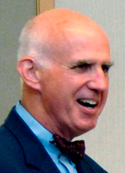December 12, 2011
Celebrating Tom Birch

Tom Birch
Tom Birch has announced plans to end his long and successful tenure as legislative counsel to NASAA. It’s a good time to celebrate Tom’s leadership and his contribution to public support for the arts, reflect on what NASAA has accomplished in conveying the value of state arts agency (SAA) work to decision makers, and consider how the advocacy needs of NASAA members are evolving.
At their 1980 annual meeting in Idaho, SAA leaders determined that, going forward, federal advocacy would be a strong focus of their association. In 1981, when President Reagan and his budget officer, David Stockman, began visibly to consider cutting and then eliminating the National Endowment for the Arts (NEA), NASAA members made a special contribution and contracted with Tom for a few months of assistance and part-time representation. At about the same time, he began representing the National Child Abuse Coalition. As it turns out, his relationships with both associations were to last more than 30 years. Previously, he had worked for Indiana Congressman John Brademas, a coauthor of the NEA enabling legislation and an influential voice on Capitol Hill.
Tom’s primary NASAA responsibilities have always been to coordinate SAA advocacy in support of NEA budget resources, with special emphasis on support for the portion mandated to fund states and their regional consortia. Over the years, in addition to personally advising and assisting NASAA members, he has developed a broad array of activities, materials and methods to inform and empower state spokespersons. He began by conducting the first NASAA convening in Washington, D.C., specifically to familiarize SAA leaders with NEA budget issues and ways of speaking effectively with members of Congress—followed by Hill visits. His NASAA Advocate pamphlet series now serves as the essential library of arts advocacy principles, information and practical methods. NASAA members and others who value public support for the arts have drawn upon his analysis of issues in Legislative Memos, his monthly status reports in this newsletter as Legislative Updates, and his time-sensitive calls to action in Legislative Alerts. Through the Current Congressional News and Federal Legislative Updates page on NASAA’s website, Tom keeps NASAA’s readers informed about the latest developments on our legislative agenda. As technology has enabled Tom and NASAA’s staff to share their expertise in on-line and interactive formats, self-assessment tools, overviews and other resources have become website features, and it is quite common to see NASAA advocacy materials included in state-level meetings, publications and workshops.
Tom’s guidance has been critical as NASAA and other national arts service groups have demonstrated the powerful role that well prepared, well researched, rigorously nonpartisan, organized communication could play in informing congressional decision making. In the early and mid-1990s, public funding for the arts was challenged by the “culture wars” that surrounded the NEA’s association with the work of artists Robert Mapplethorpe and Andres Serrano and performance art pieces by “the NEA Four.” The future of the NEA was in doubt. A coalition of nine arts and humanities groups including NASAA coordinated a national media campaign—raising a million dollars and engaging the Ad Council in a cultural cause for the first time. This National Cultural Alliance generated more than 100,000 messages to Congress in support of the arts and humanities endowments. This successful effort continues in the form of the Cultural Advocacy Group, which works year-round to set and coordinate a unified national agenda for federal support of the arts and culture. In reshaping the NEA, Congress expressed favor with the ability of state arts agencies to reach the underserved and to advance arts education, and doubled the percentage of the NEA budget mandated for states from 20% to 40%.
As state governments have struggled with two major recessionary cycles in the past decade, Tom has increasingly responded to requests by NASAA members for the training of council members, staff and constituents of state arts agencies in advocacy methods that can be applied at all governmental levels. In recent years, NASAA members have expressed particular appreciation for his assistance in aligning the work of state arts agencies and statewide arts advocacy groups. He is recognized as a leader among his colleagues and has served as convener of the Cultural Advocacy Group for the past five years. He has distinguished himself as well in his other field of advocacy, winning a prestigious Casey Family Programs Leadership Award for his “years of uncompromising commitment to protect and improve the lives of America’s most vulnerable children” and the national Award for Distinguished Contribution to Child Advocacy from the American Psychological Association.
Looking ahead, NASAA will seek to maintain the high standard of service its members and colleagues have come to expect from its legislative counsel. The needs of state arts agencies for professional government relations and representation, as well as for leadership development in advocacy, are extensive. Tom has generously agreed to assist NASAA as we consider our changing environment and manage this transition, and he will be working with us through the end of April 2012. Stay tuned for news of special opportunities to celebrate his work. We know that not only his NASAA family but many additional colleagues and friends will want to wish him well.
In this Issue
State to State
- Indiana: A Community Colloquium for Innovation and Growth
- Florida: Culture Builds Florida Campaign
- Utah: Change Leader Brochure
Legislative Update
Executive Director's Column
Research on Demand
SubscribeSubscribe
×
To receive information regarding updates to our newslettter. Please fill out the form below.

